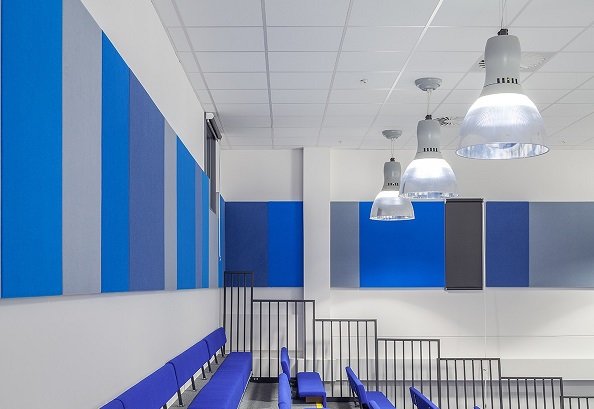
<h4 style="text-align: justify;">Background noise, also known as ambient or residual noise, comes from a range of internal and external sources such as chatter, noise in adjacent rooms, and nearby traffic.</h4>
<p style="text-align: justify;">While low levels of background noise are tolerable, high levels can be significantly disruptive to audience concentration.</p>
<p style="text-align: justify;">Research indicates that background noise levels in unoccupied New Zealand classrooms range from 28 &#8211; 60 dB (The Oticon Foundation in New Zealand). This exceeds the Ministry of Education’s (MoE) current requirement that ambient noise levels in a flexible learning space or cellular classroom should not exceed 35 – 45 dB.</p>
<p style="text-align: justify;">The combination of excessive background noise and high reverberation levels impact audience attention, particularly younger students who are not yet able to differentiate between speaker and background noise. Distribution and amplification of desired sound is greatly impacted by the architectural design of the auditorium. As previously discussed, a room’s dimensions and finish materials have a big influence on acoustic quality. </p>
<figure id="attachment_5620" aria-describedby="caption-attachment-5620" style="width: 600px" class="wp-caption aligncenter"><img class="wp-image-5620 size-full" src="https://www.schoolnews.co.nz/wp-content/uploads/2017/04/SN36-PROPERTY-Acoustics-2.jpg" alt="" width="600" height="295" /><figcaption id="caption-attachment-5620" class="wp-caption-text">Image credit: Gavin Stewart Photography</figcaption></figure>
<p style="text-align: justify;">Now that we have a basic understanding of how acoustics in an auditorium work, what can we do to resolve the acoustic battle? A combination of acoustic absorbers and reflectors are ideal to help achieve acoustic balance. Absorptive acoustic treatment such as direct-fixed or suspended panels, tiles or baffles should be applied to the ceiling space. These are beneficial to absorb sound waves as they are produced and reduce acoustic reflection to an acceptable standard. Walls facing the speaker should be lined with acoustic material, panel or tile, while the wall behind the speaker should be left as a hard surface to help reflect sound towards to audience. Like the advised ceiling treatment, applying a sound absorbing lining to the facing walls is beneficial to reduce excessive sound reflection. </p>
<figure id="attachment_5626" aria-describedby="caption-attachment-5626" style="width: 596px" class="wp-caption aligncenter"><img class="wp-image-5626" src="https://www.schoolnews.co.nz/wp-content/uploads/2017/04/SN36-PROPERTY-Acoustics-3.jpg" alt="" width="596" height="430" /><figcaption id="caption-attachment-5626" class="wp-caption-text">Image credit: Gavin Stewart Photography</figcaption></figure>
<p style="text-align: justify;">There are many acoustic assessors and products for acoustic treatment available. If you believe your auditorium suffers from acoustic chaos, seek assistance from an acoustic specialist who can provide an in-depth analysis using acoustic testing equipment. Seek out advice from a consultant who has experience and knowledge in treating acoustics in an educational environment.</p>
<p style="text-align: justify;">For more information about acoustics in education, refer to the MoE guide, Designing Quality Learning Spaces: Acoustics.</p>
<p style="text-align: justify;"><em><i>Reference: </i></em><a href="http://www.oticon.org.nz/pdf/classroomacousticsreportprintedversion.pdf" target="_blank"><em><i>http://www.oticon.org.nz/pdf/classroomacousticsreportprintedversion.pdf </i></em></a></p>
<p style="text-align: justify;"><a href="http://www.education.govt.nz/assets/Documents/Primary-Secondary/Property/School-propertydesign/Flexible-learning-spaces/DQLS-AcousticsV2.0.pdf" target="_blank"><em><i>http://www.education.govt.nz/assets/Documents/Primary-Secondary/Property/School-propertydesign/Flexible-learning-spaces/DQLS-AcousticsV2.0.pdf</i></em></a></p>

NZEI Te Riu Roa is considering legal action against the government for the disestablishment of…
NZQA is implementing AI-marking for all Year 10 written assessments from this year onwards, following…
Teaching personal financial responsibility isn't enough. Children should be taught broader economic context, argue New…
When students can't hear the teacher, they can't learn properly. Sound quality matters in education…
The Garden City is rich with learning opportunities, no matter what subject or part of…
Teaching Council of Aotearoa launch school leaders’ stories project with Unteach Racism to challenge institutional…
This website uses cookies.